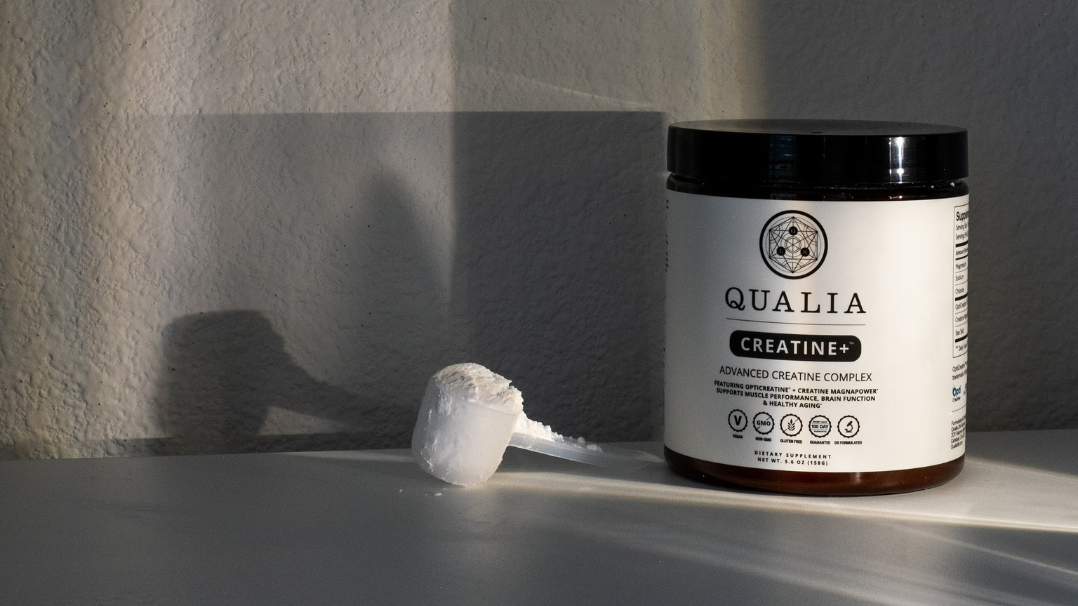What is Magnesium Glycinate?
Magnesium glycinate is a chelated form of magnesium also known as magnesium bisglycinate and magnesium bisglycinate chelate. It consists of one magnesium ion bound to two glycine molecules. Magnesium is one of the most abundant minerals in the body and plays a vital role in supporting the function of all living cells. Glycine is an amino acid used to make many proteins in the body. It also acts as a calming neurotransmitter in the brain. Because both magnesium and glycine support relaxation, Magnesium bisglycinate is recommended as one of the more calming forms of magnesium supplements.*
Understanding Low Magnesium Levels
Magnesium is an essential nutrient, which means it must be obtained from dietary sources to keep our cells working optimally and maintain general health and well-being. Not getting enough magnesium in the diet can result in a gradual decline in cellular magnesium levels that may negatively impact multiple aspects of cellular function, namely gene expression, genetic stability, mitochondrial function, cell division and growth, cellular metabolism and metabolic health, and cellular ability to degrade and recycle damaged molecules and cellular structures; all these changes may even contribute to cellular senescence [1–9]. These effects can be particularly impactful as we age and contribute to an acceleration of the aging process [10].*
Ensuring you meet the adequate daily intake of magnesium, either through foods or supplementation, may help to resist these changes and contribute to optimal physical and mental well-being.*
In the table below, you can find the U.S. Food and Nutrition Board Recommended Dietary Allowances (RDAs) for Magnesium [11]:
What Does Magnesium Glycinate Do?
As a cofactor, magnesium supports the activity of over 600 enzymes, many of which are part of key cellular metabolic pathways. For example, all enzymes that use and many that synthesize ATP (the cell energy molecule) are supported by magnesium. Furthemore, ATP must form a complex with magnesium (MgATP) to be biologically active. Therefore, magnesium has a core function in cellular energy metabolism and is essential to all cellular activities that rely on cellular energy, such as division and growth, building molecules such as DNA and proteins, and assembling cellular structures such as mitochondria, just to name a few [12].*
Optimal cellular energy metabolism is crucial for maintaining healthy cell, tissue, and organ function. This applies to all types of tissues and organs, but it is particularly relevant for those with high energy demands, like the brain, for example. If brain magnesium levels are insufficient, cerebral metabolism may be affected and can lead to feelings of low mental energy and lack of motivation, more difficulty concentrating, and a tendency to be easily distracted. Optimal magnesium levels may help the brain meet its energy needs and support energy-demanding cognitive tasks such as sustained attention, maintaining focus, reasoning, and decision-making.*
But there are many other roles and benefits of magnesium for brain health: it is also fundamental for neurotransmitter synthesis, neuronal communication, neuroplasticity, and neuroprotection. These are all essential for optimal brain function and supporting cognitive performance, particularly as we age and brain magnesium levels tend to decline [13–17].*
By upholding these processes, magnesium may support many aspects of mental well-being that depend on optimal brain function—relaxation and sleep are two good examples. Magnesium has a number of roles that can directly benefit healthy stress responses and sleep mechanisms, including being a cofactor that supports the production of several important neurotransmitters and neurohormones involved in those functions [18–21]. Through these actions, magnesium supports physiological responses to stress and sleep physiology, contributing to a support of mental well-being and sleep quality [22–26].*
Magnesium glycinate is also a source of glycine, which has benefits of its own. Glycine is a neurotransmitter [27–30]. Glycinergic signaling supports the activity of major neurotransmitters such as glutamate and serotonin [31,32]. Glycine has been shown to support sleep quality in humans, helping combat daytime sleepiness and fatigue [33–35].*
In addition to its neurotransmitter role, glycine is a proteinogenic amino acid, meaning it is used to build proteins in the human body. Glycine is used to make collagen [36], which is an important structural protein in several tissues, including the skin. It is also used to make glutathione, which is one of the most important antioxidant molecules in our cells, essential for their protection from oxidative stress [37–39].*
Natural Sources of Magnesium
Magnesium is naturally found in foods and beverages such as mineral water. Foods high in magnesium include seeds, nuts, legumes, and whole grains. These are all great options to help you reach your recommended daily magnesium intake goal. Drinking plenty of mineral water rich in magnesium (magnesium content in water can vary, check the labels) is also an easy way to incorporate magnesium in your diet. You can learn more about good dietary sources of magnesium in our article on Magnesium Rich Foods.
Magnesium Supplements
Supplying adequate amounts of magnesium to your body is essential to well-being. Including magnesium rich foods in your diet is the most obvious choice to be made. However, that doesn't necessarily mean you’re getting all the magnesium you need. The fact is that, unfortunately, industrial farming methods and food processing have been steadily decreasing the magnesium content in vegetables and fruits over the last decades. For example, up to 80% of magnesium may be lost with food processing alone [40,41]. Furthermore, not all mineral waters are good sources of magnesium because water purification processes can also reduce the mineral content of bottled water, which could otherwise be a good source of magnesium [42–44].
The consequence of water purification, food processing, and soil nutrient depletion is an insufficiency of magnesium in the diets of most people in Western countries [12,45–47], resulting in low magnesium levels in their bodies. Low magnesium levels are particularly common in older adults due to an age-related decline in the intestinal absorption of magnesium and an increase in its urinary elimination due to reduced kidney function [15,16].
Magnesium supplements can be a great option to complement your dietary choices and get all the magnesium you need every day.* Similarly, although our body can synthesize glycine, there are circumstances where the amount we’re able to make and what we get in the diet may be insufficient to optimize functional health. Magnesium glycinate is therefore a good option to help maintain adequate levels of both magnesium and glycine, which is one of the reasons it is in Qualia Magnesium+®, our recent addition to our Qualia supplements line.
Key benefits & uses of magnesium glycinate include:
Support healthy magnesium levels*
Support cellular energy and metabolism*
Support muscle function*
Support relaxation and sleep quality*
Supplement general health and well-being*
Qualia Magnesium+® features 10 forms of magnesium and 70+ minerals. Shop now!
Frequently Asked Questions
Is it okay to take magnesium glycinate every day?
Magnesium glycinate can be taken every day as long as it is in amounts within the Tolerable Upper Intake Level of magnesium from dietary supplements (see National Institutes of Health - Office of Dietary Supplements).
Which is better, magnesium citrate or magnesium glycinate?
Magnesium citrate and magnesium glycinate are two excellent forms of magnesium. Rather than thinking of one as being better than the other, we believe they are complementary. Both magnesium citrate and magnesium glycinate have good bioavailability and support optimal magnesium levels in the body. Magnesium citrate is a magnesium salt of citric acid, whereas magnesium glycinate is a chelate of magnesium and glycine. Both citrate and glycine have physiological functions in the human body: citrate is an intermediate of the citric acid cycle, a key pathway of cell energy metabolism; glycine is an amino acid used to make proteins and a neurotransmitter. Both of these forms can help increase brain magnesium, but magnesium citrate may be the better form for supporting muscle magnesium balance [48].*
Does magnesium help with sleep?
Some people, but not everyone, may experience magnesium glycinate as a supplement that promotes sleepiness. Both magnesium and glycine, the two compounds that make up magnesium glycinate support relaxation and sleep. Magnesium has been shown to support sleep quality in humans. Glycine has also been shown to support sleep quality, helping to combat daytime sleepiness and fatigue.*
*These statements have not been evaluated by the Food and Drug Administration. This product is not intended to diagnose, treat, cure, or prevent any disease.
References
[1]J. Takaya, A. Iharada, H. Okihana, K. Kaneko, Epigenetics 6 (2011) 573–578.
[2]M. Liu, H. Liu, F. Feng, A. Xie, G.-J. Kang, Y. Zhao, C.R. Hou, X. Zhou, S.C. Dudley Jr, J. Am. Heart Assoc. 10 (2021) e020205.
[3]G. Calviello, P. Ricci, L. Lauro, P. Palozza, A. Cittadini, Biochem. Mol. Biol. Int. 32 (1994) 903–911.
[4]B.P. Kumar, K. Shivakumar, Biol. Trace Elem. Res. 60 (1997) 139–144.
[5]D. Maguire, O. Neytchev, D. Talwar, D. McMillan, P.G. Shiels, Int. J. Mol. Sci. 19 (2018).
[6]N. Veronese, A. Zurlo, M. Solmi, C. Luchini, C. Trevisan, G. Bano, E. Manzato, G. Sergi, R. Rylander, Am. J. Alzheimers. Dis. Other Demen. 31 (2016) 208–213.
[7]R. Bai, M.Z. Miao, H. Li, Y. Wang, R. Hou, K. He, X. Wu, H. Jin, C. Zeng, Y. Cui, G. Lei, Arthritis Res. Ther. 24 (2022) 165.
[8]S. Ferrè, A. Mazur, J.A.M. Maier, Magnes. Res. 20 (2007) 66–71.
[9]D.W. Killilea, B.N. Ames, Proc. Natl. Acad. Sci. U. S. A. 105 (2008) 5768–5773.
[10]L.J. Dominguez, N. Veronese, M. Barbagallo, Nutrients 16 (2024).
[11]Institute of Medicine, Food and Nutrition Board, Standing Committee on the Scientific Evaluation of Dietary Reference Intakes, Dietary Reference Intakes for Calcium, Phosphorus, Magnesium, Vitamin D, and Fluoride, National Academies Press, 1999.
[12]J.H.F. de Baaij, J.G.J. Hoenderop, R.J.M. Bindels, Physiol. Rev. 95 (2015) 1–46.
[13]J.A.M. Maier, L. Locatelli, G. Fedele, A. Cazzaniga, A. Mazur, Int. J. Mol. Sci. 24 (2022).
[14]M. Afsharfar, M. Shahraki, M. Shakiba, O. Asbaghi, A. Dashipour, Clin Nutr ESPEN 42 (2021) 381–386.
[15]M. Barbagallo, L.J. Dominguez, Curr. Pharm. Des. 16 (2010) 832–839.
[16]M. Barbagallo, N. Veronese, L.J. Dominguez, Nutrients 13 (2021).
[17]A.E. Kirkland, G.L. Sarlo, K.F. Holton, Nutrients 10 (2018).
[18]C. Gottesmann, Neuroscience 111 (2002) 231–239.
[19]E. Poleszak, Pharmacol. Rep. 60 (2008) 483–489.
[20]A.J. Billyard, D.L. Eggett, K.B. Franz, Magnes. Res. 19 (2006) 157–161.
[21]D. Chollet, P. Franken, Y. Raffin, J.G. Henrotte, J. Widmer, A. Malafosse, M. Tafti, Behav. Genet. 31 (2001) 413–425.
[22]A. Rawji, M.R. Peltier, K. Mourtzanakis, S. Awan, J. Rana, N.J. Pothen, S. Afzal, Cureus 16 (2024) e59317.
[23]G.A. Eby, K.L. Eby, Med. Hypotheses 67 (2006) 362–370.
[24]N.B. Boyle, C. Lawton, L. Dye, Nutrients 9 (2017) 429.
[25]B. Abbasi, M. Kimiagar, K. Sadeghniiat, M.M. Shirazi, M. Hedayati, B. Rashidkhani, J. Res. Med. Sci. 17 (2012) 1161–1169.
[26]K. Held, I.A. Antonijevic, H. Künzel, M. Uhr, T.C. Wetter, I.C. Golly, A. Steiger, H. Murck, Pharmacopsychiatry 35 (2002) 135–143.
[27]J.W. Johnson, P. Ascher, Nature 325 (1987) 529–531.
[28]H. Betz, B. Laube, J. Neurochem. 97 (2006) 1600–1610.
[29]F. Zafra, C. Giménez, IUBMB Life 60 (2008) 810–817.
[30]A.A. Ghavanini, D.A. Mathers, H.-S. Kim, E. Puil, J. Neurophysiol. 95 (2006) 3438–3448.
[31]S.F. Traynelis, L.P. Wollmuth, C.J. McBain, F.S. Menniti, K.M. Vance, K.K. Ogden, K.B. Hansen, H. Yuan, S.J. Myers, R. Dingledine, Pharmacol. Rev. 62 (2010) 405–496.
[32]M. Bannai, N. Kawai, K. Nagao, S. Nakano, D. Matsuzawa, E. Shimizu, Psychiatry Clin. Neurosci. 65 (2011) 142–149.
[33]W. Yamadera, K. Inagawa, S. Chiba, M. Bannai, M. Takahashi, K. Nakayama, Sleep Biol. Rhythms 5 (2007) 126–131.
[34]M. Bannai, N. Kawai, K. Ono, K. Nakahara, N. Murakami, Front. Neurol. 3 (2012) 61.
[35]K. Inagawa, T. Hiraoka, T. Kohda, W. Yamadera, M. Takahashi, Sleep Biol. Rhythms 4 (2006) 75–77.
[36]M.D. Shoulders, R.T. Raines, Annu. Rev. Biochem. 78 (2009) 929–958.
[37]S.C. Lu, Biochim. Biophys. Acta 1830 (2013) 3143–3153.
[38]A. Ruiz-Ramírez, E. Ortiz-Balderas, G. Cardozo-Saldaña, E. Diaz-Diaz, M. El-Hafidi, Clin. Sci. 126 (2014) 19–29.
[39]M.F. McCarty, J.H. O’Keefe, J.J. DiNicolantonio, Ochsner J. 18 (2018) 81–87.
[40]R. Cazzola, M. Della Porta, M. Manoni, S. Iotti, L. Pinotti, J.A. Maier, Heliyon 6 (2020) e05390.
[41]A. Rosanoff, Plant Soil 368 (2013) 139–153.
[42]S.J.M. Stoots, G.M. Kamphuis, R. Geraghty, L. Vogt, M.M.E.L. Henderickx, B.M.Z. Hameed, S. Ibrahim, A. Pietropaolo, E. Jamnadass, S.M. Aljumaiah, S.B. Hamri, E. Ventimiglia, O. Traxer, V. Gauhar, E.X. Keller, V. De Coninck, O. Durutovic, N.K. Gadzhiev, L.B. Dragos, T.E. Sener, N. Rukin, M. Talso, P. Kallidonis, E. Emiliani, E. Bres-Niewada, K.B. Scotland, N. Bhojani, A. Vagionis, A. Piccirilli, B.K. Somani, J. Clin. Med. Res. 10 (2021).
[43]S.J.M. Stoots, R. Geraghty, G.M. Kamphuis, E. Jamnadass, M.M.E.L. Henderickx, E. Ventimiglia, O. Traxer, E.X. Keller, V. DeConinck, M. Talso, P. Kallidonis, E. Emiliani, E. Bres-Niewada, S.S. Karim, A. Picirilli, B.K. Somani, J. Endourol. 35 (2021) 206–214.
[44]S.J.M. Stoots, R. Geraghty, G.M. Kamphuis, E. Jamnadass, M.M.E.L. Henderickx, E. Ventimiglia, O. Traxer, E.X. Keller, V. De Coninck, M. Talso, P. Kallidonis, E. Emiliani, E. Bres-Niewada, S.S. Karim, A. Piccirilli, A. Vagionis, B.K. Somani, Cent European J Urol 74 (2021) 71–75.
[45]J.J. DiNicolantonio, J.H. O’Keefe, W. Wilson, Open Heart 5 (2018) e000668.
[46]G. Pickering, A. Mazur, M. Trousselard, P. Bienkowski, N. Yaltsewa, M. Amessou, L. Noah, E. Pouteau, Nutrients 12 (2020).
[47]V. Worthington, J. Altern. Complement. Med. 7 (2001) 161–173.
[48]M. Ates, S. Kizildag, O. Yuksel, F. Hosgorler, Z. Yuce, G. Guvendi, S. Kandis, A. Karakilic, B. Koc, N. Uysal, Biol. Trace Elem. Res. 192 (2019) 244–251.








No Comments Yet
Sign in or Register to Comment